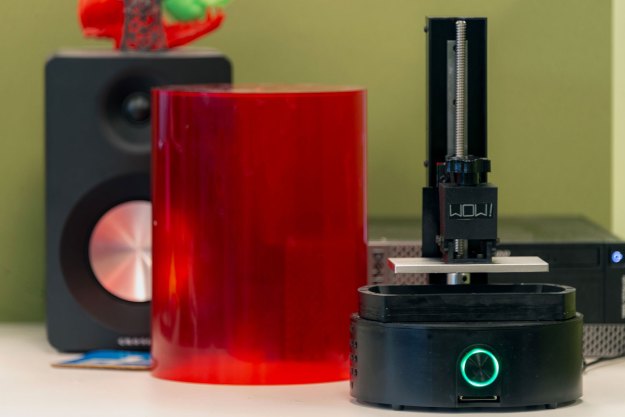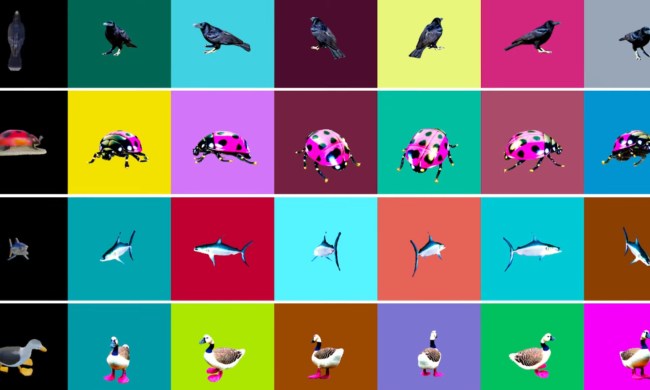
“Sparkmaker is definitely a “fixer-upper.” In other words, you should steer clear unless you’re prepared to do some tinkering”
- Affordable
- High print resolution
- Compact and quiet
- Cheap construction
- Buggy software
- Small build volume
- Unreliable prints
Back when 3D printing was just beginning to make its way into the mainstream, the only printers available to consumers used a technique called filament deposition modeling (FDM). It’s the type of 3D printing you’ve probably seen before: A printer feeds a strand of plastic filament through a hot nozzle, then carefully deposits the molten goo onto a build plate, layer by layer, to create a 3D object.
This is by far the most popular and widely available style of 3D printer, but lately, a technology known as stereolithography (SLA) has been on the rise. SLA printers create objects by flashing light into a pool of photo-reactive resin, which hardens when struck by UV light. Due to the precision of this technique, SLA printers typically create much better parts than FDM printers do.
The only problem, however, is that these kinds of printers have been prohibitively expensive for the past few years, and therefore been out of reach for the average consumer — but that’s beginning to change.
Case in point? The $300 Sparkmaker printer. Born from a Kickstarter project that launched in early 2017, the Sparkmaker is one of the first SLA/DLP printers to break the $500 barrier – so we got our hands on one to see how it stands up to the competition.
Standout Features and Specs
The first thing you’ll notice about the Sparkmaker is its diminutive size and weight. Tipping the scales at just six pounds, and measuring a slim 6 x 11 inches (it’s a cylinder), it’s easily one of the smallest printers on the market. So while it won’t be hard to find a spot for the little guy, it does come with a downside.
Lifting the orange UV-blocking hood reveals the printer’s tiny 4 x 2.2 x 5 inch build envelope. While that’s certainly not the smallest build area we’ve ever seen, you shouldn’t expect to do any huge prints on this machine. On the upside, Sparkmaker does feature a removable resin vat, which makes swapping materials a breeze.
The Sparkmaker owes its low price point to its relatively simple printing technique. Instead of using a laser like Formlabs’ printers, Sparkmaker uses a UV backed LCD screen to project an image up into a vat of resin, which causes it to solidify – a process known as DLP. Despite having a few minor drawbacks, this printing method provides the Sparkmaker with a maximum resolution of ten micrometers. For those of you keeping score at home, that’s ten times more detail than your average FDM printer, and about 1.5 times more detail than the $3,500 Ultimaker 3 – arguably the best consumer-level FDM machine on the market right now.
Setup and Configuration
Unlike FDM printers, the Sparkmaker only has one moving component and doesn’t require any assembly, so it’s extremely simple to set up. After plugging it in, all you have to do is pour some resin into the tank and make sure the build plate is level. Once you’ve done that, you’re ready to print.
You definitely won’t find another SLA/DLP printer that can match Sparkmaker’s $300 price tag.
Then there’s the software. Like many printers these days, Sparkmaker has its own proprietary slicing program that can be downloaded for free on the manufacturer’s website. It’s called Sparkstudio, and compared to most other proprietary slicing programs, it’s one of the most intuitive and approachable ones we’ve ever used.
Unfortunately, we did encounter a few bugs that soured the experience (more on that later), but broadly speaking, this printer is a cinch to set up.
Design and Build Quality
Sparkmaker is inexpensive for a reason. Most of the body is made of plastic, and the parts feel a bit flimsy and cheap. The creators definitely cut some corners during manufacturing, and it shows.
The biggest misstep in the machine’s design is a tiny component called a “lead screw.” It’s a little threaded tube that keeps the build plate moving smoothly along the Z axis — or at least that’s what it’s supposed to do. Due to this component’s faulty design, the build plate’s up-and-down motion is prone to periodic jerks and jumps, which causes issues during the printing process.

There is a fairly simple workaround for this problem, though. Following some advice from the Sparkmaker Facebook group, we used a different 3D printer to print a new lead screw. This simple replacement drastically improved the printer’s success rate and overall consistency. If you intend on buying this printer, you should definitely plan on replacing that screw.
Aside from the faulty lead screw, the rest of the printer works fairly well. The removable resin tank is easy to take out and replace, and the build plate itself is secured via a single knobbed screw, which streamlines the process of getting your finished print out of the printer.
Another bonus is that, generally speaking, the Sparkmaker is incredibly easy to take apart and work on – which is good, because it definitely requires some tinkering.
User Interface and Software
Sparkmaker’s on-board user interface is practically nonexistent, and is comprised of nothing more than a single push knob. However, unlike other printers that utilize this design, that’s all the Sparkmaker gives you. It doesn’t have an accompanying screen for you to navigate with, so the machine lacks a variety of helpful functions as a result. These include: being able to pause a print, the ability to adjust machine settings without plugging in to a computer, and the ability to select specific files on your SD card for printing. The latter is particularly annoying, as you’re then forced to either remove old files or rename them. Sparkmaker will only recognize sliced files named “Print.wow.” It’s not the worst problem you could ever have, but it’s definitely one of those bothersome quirks that make the machine a pain to work with.
Due to software bugs and hardware flaws, this machine has a woefully above-average failure rate.
Luckily, the accompanying desktop software, Sparkstudio, partially makes up for these issues with a stellar interface that’s simultaneously feature-rich and easy to navigate. In other words, it’s simple and approachable for beginners, but also provides deep print customization options, so intermediate and advanced users aren’t left out to dry.
Much to our delight, Sparkstudio also features a tool that’s generally only available on high-end slicing software: customizable supports you can manually place or remove. If that’s not your bag, the software still includes automatic support placement, which you can then modify posthumously. It’s really neat, and we wish more slicing programs offered this kind of functionality.
However, even with all the good, Sparkstudio suffers a couple of crippling flaws that sour the experience. First, there’s a scaling bug that randomly adjusts the length, width, height, or size of the objects you slice – without giving you any clues or warnings that it’s done so. During our testing, this resulted in a 3DBenchy tugboat that was twice as tall as it should’ve been, and a skull that was roughly one tenth the height we originally set for it. This bug, combined with an inconsistency in what caused our prints to fail, pushed us to use a different slicer program entirely. We ended up using SLAcer: a user-made slicer that eliminates Sparkstudio’s aforementioned bugs, but also lacks many of its best features – including the custom support placement feature.
All things considered, Sparkstudio has tremendous potential, but is held back by a couple glaring flaws. It’s possible that WOW! might fix these issues in the future, but in its current state, the software is frustratingly buggy. So until those problems get fixed, you’re stuck using a more dependable but less feature-packed slicing program.
Print Performance
Despite the issues with consistency and slicing bugs, the Sparkmaker prints surprisingly well – (when it finishes, that is). With its maximum Z-axis resolution of 10 microns, this little machine can print some amazing detail and super fine geometry. There’s a slight amount of voxeling visible on some of our test prints (a consequence of the printer’s DLP printing technique), but the effect is only noticeable if you’re looking for it.

Overall, the Sparkmaker’s virtues outweigh its flaws when it comes to print quality. It’s definitely not on the same level as, say, the Formlabs Form 2, but let’s not forget that this is a $300 printer we’re talking about here. It’s one tenth the price of a top-of-the-line machine, yet offers only slightly lower quality. That’s pretty impressive.
Print quality is only one part of the equation, though. Consistency and reliability are the other part of it, and unfortunately, that’s where Sparkmaker falls short. Due to the aforementioned software bugs and hardware flaws, this machine has a woefully above-average failure rate.
Even with all of its flaws and shortcomings, we did enjoy this printer.
Even after we had addressed the lead screw issue and switched to a less-buggy slicing program, we still experienced a high number of botched prints. By our count, you’ve got a 50/50 chance that the print won’t adhere properly to the build plate. You can mitigate this issue by printing with an improvised “raft” on the bottom of your object – but that raft won’t be removable, and there’s still a good chance it won’t stick anyway.
All in all, we’d say that the Sparkmaker produces impressively detailed prints about 30 percent of the time. The other 70 percent, you wind up with something that resembles postmodern glitch art. We’ll continue working on it though, and will update this article if we figure out how to get better, more consistent prints.
Our Take
Even with all of its flaws and shortcomings, we did enjoy this printer. Its compact, it’s quiet, and it’s the only printer we’ve ever tested that didn’t drive everyone in the office crazy with its fumes or noise. It’s also highly affordable, relatively easy to upgrade, and occasionally produces stellar prints.
That said, Sparkmaker definitely isn’t a good printer for beginners. In its current state it’s too flawed, too buggy, and too unreliable for us to recommend to anyone who is just breaking into the 3D printing scene. However, if you enjoy a little challenge and aren’t afraid of getting your hands dirty, the Sparkmaker is a fixer-upper that might be worth your time.
Is there a better alternative?
You definitely won’t find another SLA/DLP printer that can match Sparkmaker’s $300 price tag. However, there are a couple competitors out there that you can snag for around $500 – such as the Wanhao Duplicator 7, which boasts a slightly larger build volume, and a built-in screen for menu navigation.
If you don’t have your heart set on an SLA/DLP printer, there’s a handful of good FDM printers on the market you can get your paws on for around $300. For budget buyers, we highly recommend Monoprice’s $160 Mini Delta printer. It can’t match the Sparkmaker’s print resolution, but it does boast a larger build area, and is far more reliable.
For those who don’t mind spending a bit more, you can also get yourself a Monoprice Maker Select Plus for $400. It’s a bit more expensive, but for that extra $100, you’ll get considerably larger build area and a wide range of high-end features.
How long will it last?
With its cheap parts and plastic chassis, the Sparkmaker’s lifespan will likely definitely depend on how you treat it. Without regular maintenance, we’d be willing to bet things will fail after a year or two. However, if you keep it tuned up and well-oiled, it’ll probably keep on ticking past the age of 5 – assuming that WOW! keeps pushing out firmware updates and bug fixes.
On the plus side, Sparkmaker’s community is brimming with guides for fixes and upgrades. We found endless support through the Facebook community as we encountered problems, both from other users and the developers themselves.
Should you buy it?
If you’re new to 3D printing and you want something that’s easy to use, definitely don’t buy this printer. We guarantee it will make you pull your hair out. However, if you’re ready to get messy and have the gumption to make a few DIY upgrades, then Sparkmaker might be up your alley. With a bit of tinkering, you can definitely make this machine shine.







